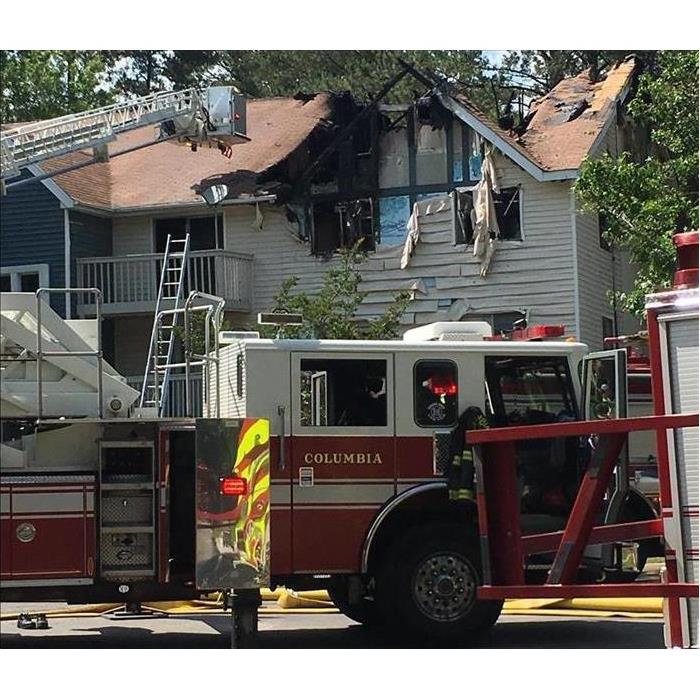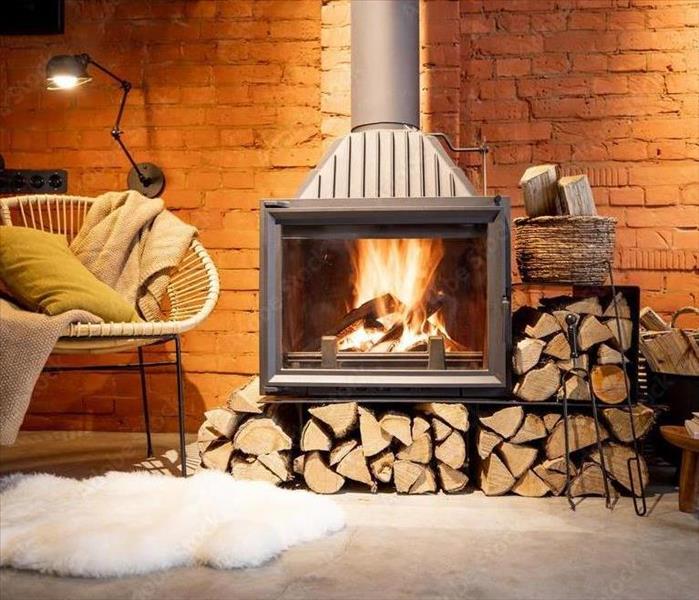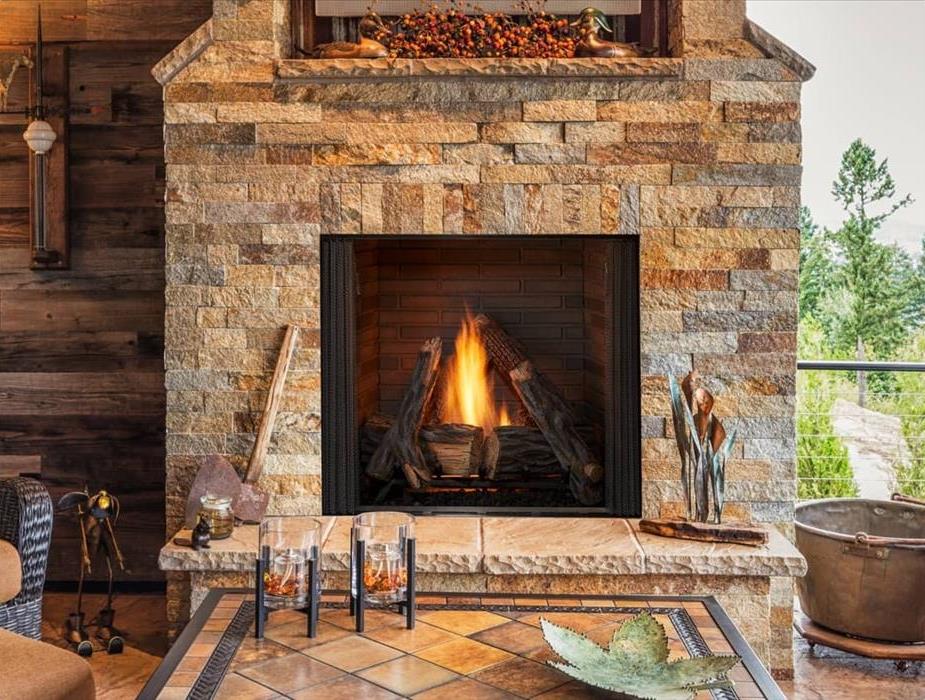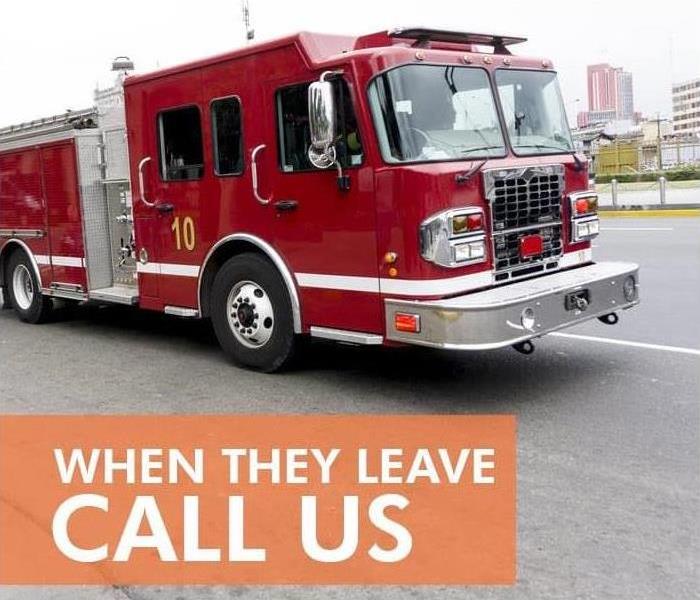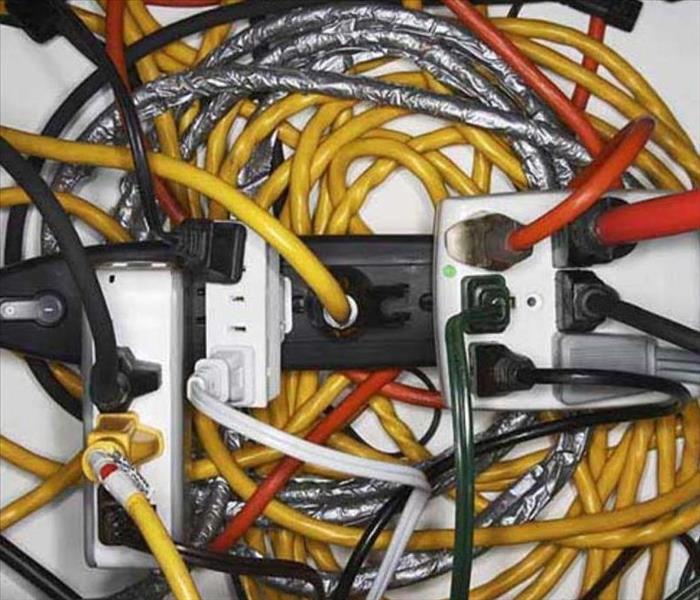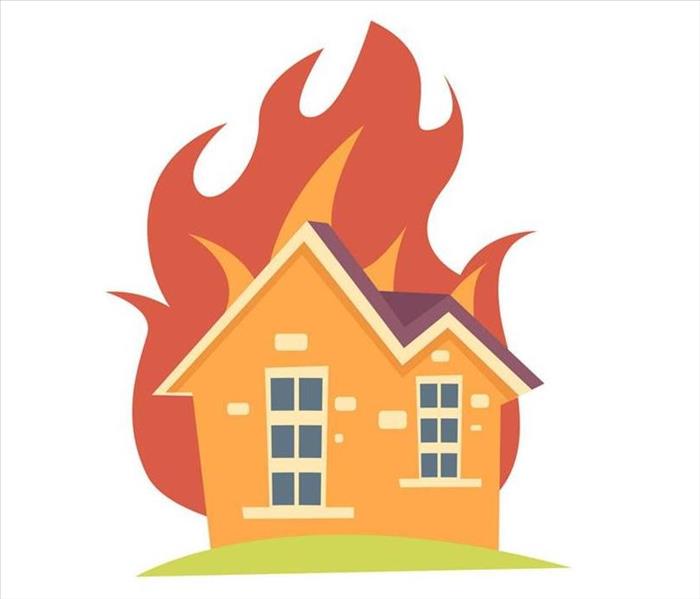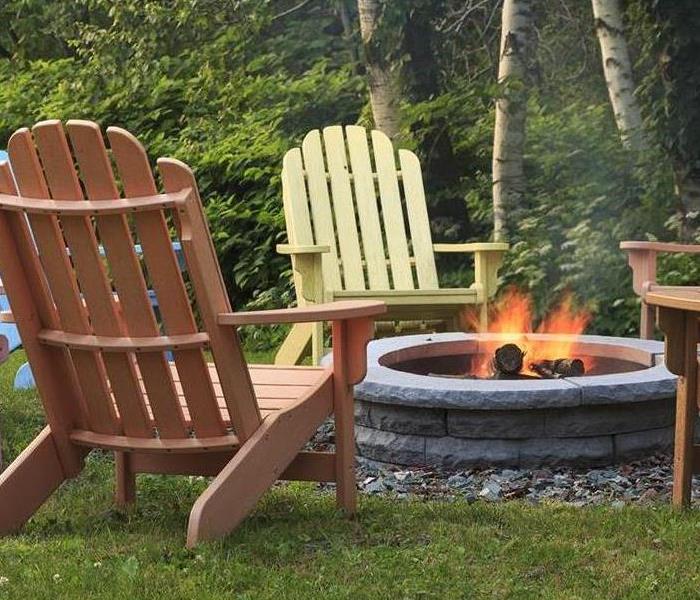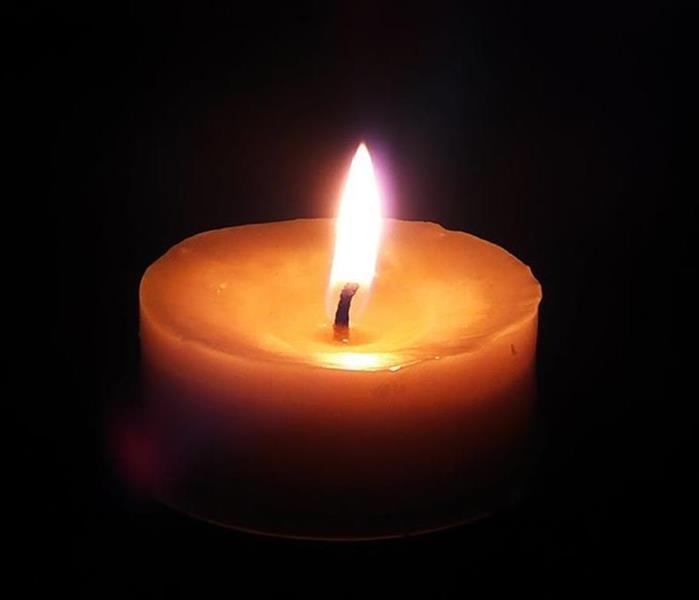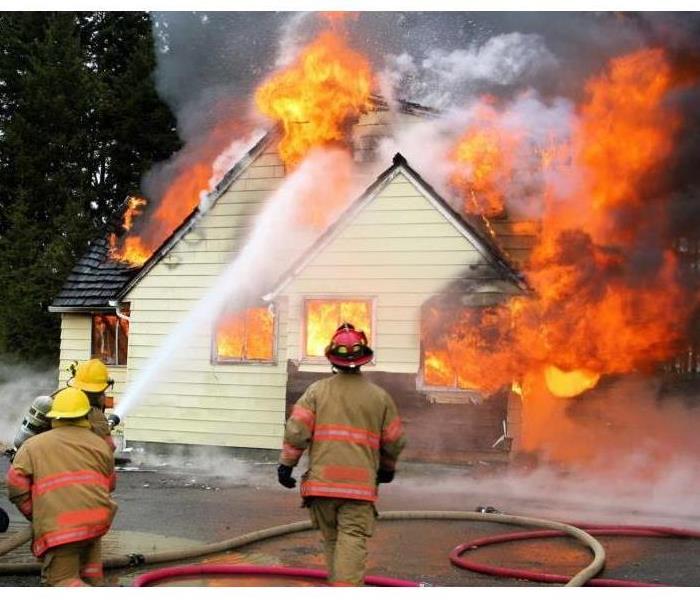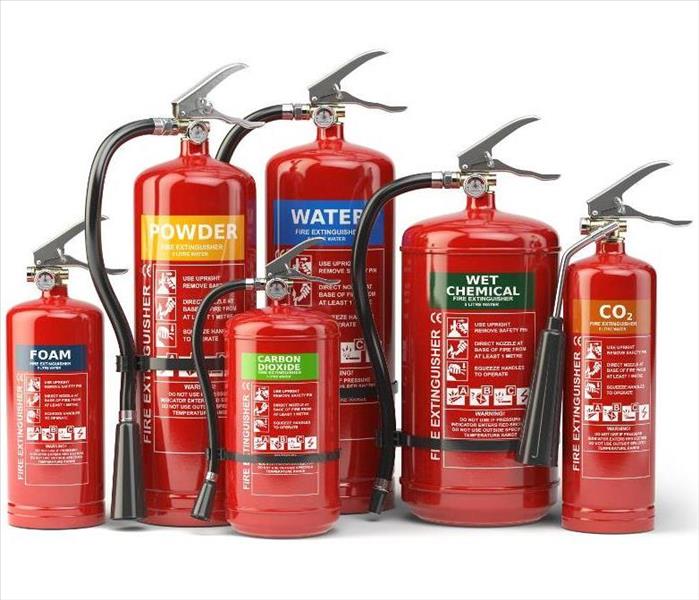Recent Fire Damage Posts
Understanding Residential Fire Damage: A Comprehensive Guide by SERVPRO Team Cox
7/9/2024 (Permalink)
A fire in your home can be a devastating experience, leaving you with emotional, physical, and financial challenges. At SERVPRO® Team Cox, we understand the unique difficulties that residential fire damage presents, especially in a vibrant and historic city like Columbia, SC. This comprehensive guide will explore the critical aspects of residential fire damage and how our expert team can help restore your home to its pre-fire condition.
The Immediate Aftermath of Residential Fire Damage
Once the flames are extinguished, the immediate aftermath of a fire involves several crucial steps:
- Safety First: Ensure that all occupants and pets are safe. Do not re-enter the home until it has been declared safe by the fire department.
- Contact SERVPRO Team Cox: Our 24/7 emergency services mean we can respond promptly to assess the situation and begin restoration.
- Initial Assessment: We conduct a thorough inspection to determine the extent of fire, smoke, and soot damage, as well as any water damage from firefighting efforts.
- Board-Up and Tarp Services: To secure the property and prevent further damage, our team provides emergency board-up and roof-tarp services.
The Impact of Fire Damage on Homes
Residential fire damage goes beyond the visible destruction. Here are some of the less obvious impacts:
- Structural Damage: Fire can weaken the structural integrity of your home, affecting walls, ceilings, and floors.
- Smoke and Soot Damage: Smoke and soot can infiltrate your home, causing persistent odors and potential health risks.
- Water Damage: Firefighting efforts often result in water damage, which can lead to mold growth if not addressed promptly.
- Personal Belongings: Fire can destroy personal belongings, including furniture, clothing, and sentimental items.
The SERVPRO Team Cox Approach to Residential Fire Restoration
At SERVPRO Team Cox, we follow a systematic approach to residential fire restoration, ensuring thorough and efficient recovery:
- Emergency Contact: Our 24/7 availability means we can respond to emergencies promptly. Quick action is crucial in minimizing damage and costs.
- Inspection and Fire Damage Assessment: We conduct a detailed inspection to determine the extent of fire, smoke, and soot damage.
- Immediate Board-Up and Roof-Tarp Service: To secure the property and prevent further damage, we provide immediate board-up and roof-tarp services.
- Water Removal and Drying (if water damage is present): Using advanced equipment, we remove water and thoroughly dry the affected areas.
- Smoke and Soot Removal: Our specialized equipment and techniques remove smoke and soot from all surfaces.
- Cleaning and Sanitizing: We clean, sanitize, and disinfect all restorable items and structures. This includes odor removal using industrial air scrubbers and fogging equipment.
- Restoration: This is the final step, involving minor repairs like replacing drywall, painting, and installing new carpet, or major repairs like reconstructing areas of the property.
Why Choose SERVPRO Team Cox for Residential Fire Restoration?
- Experience and Expertise: With years of experience in fire damage restoration, our team has the knowledge and skills to handle any size disaster.
- Advanced Technology: We use state-of-the-art equipment and techniques to ensure efficient and effective restoration.
- Comprehensive Services: From initial assessment to final restoration, we provide a full range of services to get your home back to normal.
- Customer-Centric Approach: We understand the stress and disruption caused by fire damage. Our team is committed to providing compassionate and responsive service throughout the restoration process.
Case Study: Successful Residential Fire Restoration by SERVPRO Team Cox
To illustrate our capabilities, let’s look at a recent case where SERVPRO Team Cox successfully restored a home after a fire:
Case Study: Restoring a Family Home in Columbia, SC
Background: A kitchen fire in a family home in Columbia caused extensive damage. The fire was contained quickly, but smoke and soot spread throughout the house, affecting multiple rooms.
Challenges:
- Soot covered walls, ceilings, and furniture in the kitchen and adjacent rooms.
- Smoke had infiltrated the HVAC system, spreading odors and residues throughout the house.
- The family needed to return to their home as soon as possible.
SERVPRO Team Cox’s Approach:
- Immediate Response: We arrived on-site promptly and conducted a thorough assessment of the damage.
- Comprehensive Cleaning: Our team used specialized equipment to remove soot from all surfaces, including walls, ceilings, and furniture.
- HVAC Cleaning: We cleaned the HVAC system to remove smoke residues and prevent further spread of odors.
- Odor Removal: Using thermal fogging and ozone treatments, we effectively eliminated smoke odors from the entire house.
- Restoration: Minor repairs were carried out, including repainting and carpet cleaning, to restore the home to its pre-fire condition.
Outcome: The family was able to return to their home quickly, with no lingering smoke odors or health risks. The thorough cleaning and restoration ensured the house was safe and comfortable.
Preventive Measures for Residential Fire Damage
While it’s impossible to eliminate all risks, taking preventive measures can significantly reduce the likelihood of fire damage in your home:
- Fire Alarms and Detectors: Ensure your home is equipped with working smoke alarms and carbon monoxide detectors.
- Regular Maintenance: Keep heating systems, chimneys, and appliances in good working order to prevent fires.
- Fire Safety Plan: Develop and regularly update a fire safety plan, ensuring all occupants know how to respond in case of a fire.
- Fire-Resistant Materials: Consider using fire-resistant materials in construction and renovations to minimize damage in the event of a fire.
Contact SERVPRO Team Cox for Expert Fire Damage Restoration
If your home has been affected by fire damage, don’t wait – contact SERVPRO Team Cox immediately. Our experienced team is ready to respond 24/7, providing expert fire damage restoration services to get your home back on its feet.
Facing residential fire damage can be an overwhelming experience, but with SERVPRO Team Cox by your side, you don’t have to navigate it alone. Our comprehensive fire damage restoration services are designed to address every aspect of the recovery process, ensuring your property is restored quickly and efficiently. Trust SERVPRO Team Cox to be your partner in recovery, providing the expertise, compassion, and dedication needed to get your home back to normal. Contact us today to learn more about how we can help you in the aftermath of a fire.
SERVPRO Team Cox is committed to providing exceptional fire damage restoration services to homes in Columbia and the surrounding areas. With our experienced team and advanced technology, we ensure your property is restored to its pre-fire condition swiftly and efficiently. For emergency services or to learn more about our restoration process, contact SERVPRO Team Cox at 803-749-0178.
UNDERSTANDING COMMERCIAL FIRE DAMAGE IN RESTAURANTS: A GUIDE BY SERVPRO TEAM COX
6/28/2024 (Permalink)
Restaurants are vibrant hubs of culinary activity, drawing customers for meals and social gatherings. However, they are also susceptible to the risk of fire due to the presence of cooking equipment, open flames, and flammable materials. When a fire occurs in a restaurant, the consequences can be devastating, leading to significant commercial fire damage. At SERVPRO® Team Cox, we specialize in restoring restaurants affected by fire damage, helping owners recover swiftly and safely.
The Impact of Commercial Fire Damage in Restaurants
Commercial fire damage in restaurants extends beyond the immediate destruction caused by flames. It includes smoke and soot damage, water damage from firefighting efforts, and potential health hazards from compromised air quality. The aftermath of a fire can disrupt operations, resulting in financial losses and impacting the livelihoods of employees.
Common Causes of Restaurant Fires
Understanding the common causes of restaurant fires can help in taking preventive measures. Some typical causes include:
- Cooking Equipment: Grease fires and equipment malfunctions are leading causes of restaurant fires.
- Electrical Faults: Faulty wiring or overloaded circuits can spark fires.
- Improper Storage of Flammable Materials: Storing flammable materials such as cooking oils and cleaning supplies near heat sources can increase the risk of fire.
- Human Error: Negligence, such as leaving cooking equipment unattended or improper use of equipment, can lead to accidental fires.
The Restoration Process
At SERVPRO Team Cox, we follow a systematic approach to address commercial fire damage in restaurants:
- Assessment and Inspection
- Conduct a thorough inspection to determine the extent of fire, smoke, and water damage.
- Evaluate the structural integrity of the property and identify areas requiring immediate attention.
- Immediate Board-Up and Roof-Tarping
- Provide emergency board-up and roof-tarping services to secure the property and prevent further damage.
- Water Removal and Drying
- Extract water used in firefighting efforts and use advanced drying equipment to prevent mold growth and further damage.
- Smoke and Soot Removal
- Employ specialized techniques to clean and remove smoke and soot from all surfaces, including walls, ceilings, and kitchen equipment.
- Cleaning and Sanitizing
- Clean and sanitize all restorable items and structures damaged by the fire.
- Use industrial air scrubbers and fogging equipment to eliminate odors.
- Restoration and Reconstruction
- Handle all aspects of the restoration process, from minor repairs like drywall replacement and painting to major reconstruction as needed.
Key Considerations in Restoring Restaurants
- Health and Safety Compliance: Ensuring the restoration process meets health and safety standards is crucial, particularly in food preparation areas.
- Minimizing Downtime: Swift restoration is essential to minimize downtime and get the restaurant back to serving customers as quickly as possible.
- Comprehensive Documentation: Detailed documentation of the damage and restoration work is essential for insurance purposes and future reference.
Why Choose SERVPRO Team Cox?
SERVPRO Team Cox is a trusted leader in fire damage restoration. Here’s why restaurant owners rely on us for restoring their establishments:
- Expertise and Experience: Our team has extensive experience in handling commercial fire damage in restaurants, ensuring that we understand the unique challenges involved.
- Advanced Technology: We utilize state-of-the-art restoration technology and equipment to achieve the best results.
- 24/7 Emergency Response: Fires can happen at any time, and we are always ready to respond to emergencies, day or night.
- Comprehensive Services: From initial assessment to final restoration, we offer a full range of services tailored to the specific needs of restaurants.
Steps to Take Immediately After a Restaurant Fire
If your restaurant experiences a fire, taking prompt action can help mitigate damage and facilitate the restoration process. Here are some steps to consider:
- Ensure Safety: Evacuate the building and ensure that everyone is safe. Do not re-enter the premises until it is declared safe by authorities.
- Contact SERVPRO Team Cox: Call us immediately to start the restoration process. Our team is available 24/7 to respond to emergencies.
- Document the Damage: Take photos and document the extent of the damage for insurance purposes.
- Notify Your Insurance Company: Report the fire to your insurance provider and initiate the claims process.
Preventive Measures for Fire Safety in Restaurants
Taking preventive measures can significantly reduce the risk of fires in restaurants. Here are some key steps to enhance fire safety:
- Regular Maintenance of Cooking Equipment
- Ensure that all cooking equipment is regularly inspected and maintained to prevent malfunctions.
- Clean hoods, ducts, and vents to prevent grease buildup, which can ignite and cause fires.
- Proper Storage of Flammable Materials
- Store cooking oils, cleaning supplies, and other flammable materials away from heat sources and in proper containers.
- Fire Detection and Suppression Systems
- Install smoke detectors and fire alarms throughout the restaurant and ensure they are regularly maintained.
- Equip the kitchen with fire suppression systems, such as automatic sprinklers and fire extinguishers, and train staff on their proper use.
- Develop a Fire Safety Plan
- Create a comprehensive fire safety and evacuation plan.
- Conduct regular fire drills to ensure all employees are familiar with evacuation routes and procedures.
- Electrical Safety
- Conduct regular inspections of electrical systems and appliances to identify and rectify potential hazards.
- Avoid overloading circuits and ensure all electrical work is performed by licensed professionals.
- Employee Training
- Provide fire safety training to all employees, including how to prevent fires and what to do in case of an emergency.
- Encourage vigilance and immediate reporting of any fire hazards.
Case Studies: SERVPRO Team Cox in Action
To illustrate the effectiveness of our commercial fire damage restoration services, here are a few case studies showcasing our work:
Case Study 1: Fine Dining Restaurant Fire
A fine dining restaurant experienced a significant fire in the kitchen that caused extensive damage to the cooking area and dining room. SERVPRO Team Cox was called in to handle the restoration. Our team:
- Conducted a thorough assessment and developed a detailed restoration plan.
- Implemented emergency board-up services to secure the property.
- Removed water from firefighting efforts and dried the affected areas.
- Cleaned and restored kitchen equipment, dining room furniture, and décor.
- Worked closely with the restaurant owner to minimize disruption and ensure a swift reopening.
Case Study 2: Casual Dining Restaurant Kitchen Fire
A casual dining restaurant suffered a kitchen fire that spread to the surrounding areas, leaving smoke and soot throughout the establishment. SERVPRO Team Cox responded immediately to:
- Assess the damage and develop a comprehensive restoration strategy.
- Clean and restore the kitchen, focusing on removing smoke and soot.
- Remove odors and sanitize the entire restaurant.
- Coordinate with the restaurant management to ensure a smooth restoration process that allowed the business to resume operations quickly.
The SERVPRO Team Cox Commitment
At SERVPRO Team Cox, we are dedicated to providing top-notch commercial fire damage restoration services for restaurants. Our commitment to excellence is reflected in our:
- Customer-Centric Approach: We prioritize the needs and concerns of our clients, ensuring transparent communication and personalized service.
- Skilled Technicians: Our team consists of highly trained and certified professionals who are experts in fire damage restoration.
- Quality Assurance: We adhere to the highest industry standards and continually update our practices to incorporate the latest advancements in restoration technology.
Contact Us
If your restaurant has been affected by commercial fire damage, don't hesitate to reach out to SERVPRO Team Cox. Our experienced team is ready to assist you with comprehensive restoration services that will help you recover and ensure the safety and integrity of your establishment. Contact us today to learn more about how we can help you restore your restaurant and get back to serving your customers. With SERVPRO Team Cox by your side, you can rest assured that your restaurant is in the hands of trusted professionals dedicated to restoring your property and peace of mind. Call us at 803-749-0178.
Understanding Fire Damage and Insurance: A SERVPRO Guide
6/6/2024 (Permalink)
Dealing with fire damage is a stressful and overwhelming experience. Beyond the immediate aftermath of the fire, homeowners must navigate the complexities of insurance claims to ensure they receive the compensation needed for restoration. At SERVPRO®, we understand the intricacies of fire damage and insurance, and we're here to guide you through the process. Here’s what you need to know about fire damage and how to handle insurance claims effectively.
The Impact of Fire Damage
Fire damage can affect every aspect of your home, from structural integrity to personal belongings. Understanding the full extent of the damage is crucial for filing an accurate insurance claim. Fire damage typically includes:
- Structural Damage: Fire can weaken the frame of your home, damage walls, floors, and ceilings, and compromise the roof.
- Smoke and Soot Residue: Smoke and soot can penetrate walls, furniture, and personal items, causing extensive damage and health hazards.
- Water Damage: Firefighting efforts often result in water damage, which can lead to mold growth if not properly addressed.
Steps to Take After Fire Damage
After experiencing fire damage, taking immediate action is essential for a successful insurance claim and restoration process. Here are the key steps:
- Ensure Safety: Make sure everyone is safe and do not re-enter the property until it is deemed safe by authorities.
- Contact SERVPRO: Reach out to SERVPRO for emergency services. Our team will quickly respond to mitigate further damage and begin the restoration process.
- Notify Your Insurance Company: Report the fire damage to your insurance company as soon as possible. Provide them with all necessary information to start the claims process.
- Document the Damage: Take photographs and videos of all visible damage. This documentation will be crucial for your insurance claim.
- Secure the Property: Board up windows and doors to protect your property from weather and unauthorized access.
How SERVPRO Helps with Fire Damage and Insurance Claims
At SERVPRO, we are committed to making the restoration process as smooth and stress-free as possible. Here’s how we assist with fire damage and insurance claims:
- Thorough Assessment: We conduct a comprehensive inspection of your property to determine the full extent of fire damage. This assessment includes structural damage, smoke and soot residue, and water damage.
- Detailed Documentation: Our team meticulously documents all fire damage, providing detailed reports and photographs to support your insurance claim.
- Direct Communication with Insurers: We work directly with your insurance company, providing them with the necessary documentation and keeping them informed throughout the restoration process.
- Expert Restoration Services: From water removal and drying to smoke and soot cleaning, our advanced restoration techniques ensure your home is restored to its pre-fire condition.
- Continued Support: We offer ongoing support and communication, ensuring you are informed and comfortable with every step of the restoration process.
Tips for Navigating Fire Damage Insurance Claims
Filing an insurance claim for fire damage can be a complex process. Here are some tips to help you navigate it effectively:
- Understand Your Policy: Familiarize yourself with your insurance policy to understand what is covered and any limitations or exclusions.
- Keep Records: Maintain detailed records of all communication with your insurance company, including emails, phone calls, and letters.
- Seek Professional Help: Consider hiring a public adjuster if you need additional assistance with your claim. They can advocate on your behalf and help maximize your settlement.
- Be Prompt: Submit all required documents and information to your insurance company promptly to avoid delays in the claims process.
Why Choose SERVPRO for Fire Damage Restoration
- Experience and Expertise: With years of experience in fire damage restoration, our team has the knowledge and skills to handle even the most complex restoration projects.
- Advanced Technology: We use state-of-the-art equipment and techniques to ensure thorough and efficient restoration.
- Comprehensive Services: From initial assessment to final repairs, we offer a full range of services to restore your home to its pre-fire condition.
- Customer-Centric Approach: We prioritize your needs and concerns, providing personalized service and support throughout the restoration process.
Frequently Asked Questions About Fire Damage and Insurance
Understanding the fire damage restoration and insurance claim process can be complex. Here are some frequently asked questions to help clarify common concerns:
- What should I do immediately after experiencing fire damage?
- Ensure everyone's safety and avoid re-entering the property until it's safe. Contact SERVPRO for emergency services, notify your insurance company, and document the damage with photos and videos.
- How does SERVPRO assist with the insurance claim process?
- SERVPRO provides a comprehensive assessment and detailed documentation of all fire damage. We communicate directly with your insurance company, ensuring they have all the necessary information to process your claim efficiently.
- What types of fire damage are typically covered by insurance?
- Most standard homeowners’ insurance policies cover fire damage, including structural damage, smoke and soot damage, and water damage from firefighting efforts. However, coverage can vary, so it's essential to review your specific policy.
- How long does the fire damage restoration process take?
- The duration of the restoration process depends on the extent of the damage. Minor repairs might take a few days, while significant structural repairs could take several weeks or more. SERVPRO will provide a timeline based on the specific needs of your restoration project.
- Can I live in my home during the restoration process?
- This depends on the extent of the damage. In some cases, it may be safe to stay in your home, while in others, temporary relocation might be necessary. SERVPRO will assess the situation and advise you accordingly.
Additional Services Offered by SERVPRO
Beyond fire damage restoration, SERVPRO provides a range of services to ensure comprehensive recovery and maintenance of your property:
Water Damage Restoration: If your home has experienced water damage from firefighting efforts, we offer complete water extraction, drying, and dehumidification services to prevent mold growth and further damage.
Mold Remediation: In the aftermath of a fire, water damage can lead to mold growth. Our mold remediation services ensure that your home is safe and free from mold-related health risks.
Contents Cleaning and Restoration: We understand that your personal belongings are important. Our team uses advanced cleaning techniques to restore items affected by fire, smoke, and soot.
Reconstruction Services: If your home requires significant structural repairs, our reconstruction services cover everything from minor repairs to major rebuilding projects.
Fire Damage Preparedness and Prevention
Being prepared can significantly reduce the impact of fire damage. Here are some additional steps to help protect your home:
Create a Fire Safety Plan:
- Develop a comprehensive fire safety plan for your family, including evacuation routes and emergency contacts. Practice fire drills regularly to ensure everyone knows what to do in case of a fire.
Install Fire Sprinklers:
- Consider installing a fire sprinkler system in your home. Sprinklers can quickly contain and extinguish a fire, minimizing damage and providing additional safety.
Regular Home Inspections:
- Schedule regular inspections of your home’s electrical, heating, and plumbing systems to identify and address potential fire hazards.
Safe Cooking Practices:
- Never leave cooking unattended and keep flammable items away from the stove. Ensure that kitchen appliances are in good working order and clean of grease buildup.
Dealing with fire damage and navigating the insurance claim process can be daunting, but you don't have to face it alone. SERVPRO Team Cox is here to provide expert fire damage restoration services and support you through every step of the insurance claim process. Our commitment to excellence ensures that your home is restored to its pre-fire condition with minimal stress and disruption.
For immediate assistance or to learn more about our services, contact SERVPRO Team Cox at 803-749-0178.
Fall & Scented Candles
9/1/2023 (Permalink)
Fall is right around the corner!! With what feels like the hottest summer in history almost behind us, many of us are eager to eat and drink Pumpkin Spiced everything. There’s nothing cozier than watching leaves change to vibrant colors and a fall-scented candle burning (safely) in your home! Never forget that open flames are potential fire hazards. According to the National Fire Protection Association (NFPA), the careless use of candles causes nearly 10,000 residential fires each year. Here are some helpful tips you can use to avoid fires caused by candles.
- Extinguish candles whenever you leave a room or go to sleep.
- It’s best to avoid burning candles in bedrooms or sleeping areas. Opt for a flameless candle or diffuser instead.
- Maintain at least 12 inches between the candle and anything flammable (decorations, curtains/fabric, paper, plants, and clothing).
- Keep lit candles in well-ventilated areas.
- Keep candles out of reach of pets and children.
- If using a candle holder, ensure it’s sturdy and cannot be knocked over. Always place them on heat-resistant surfaces.
- Trim wicks within ¼ inch of the wax to prevent sparks from popping while burning.
- Avoid burning candles to the bottom of the jar. Extinguish a candle when there are at least two inches of wax left or ½ in if they’re in a container.
If you experience fire or smoke damage from a candle and are unsure of your next steps, call SERVPRO of The Dutch Fork (803) 749-0178. Our team has the equipment and training to quickly respond to any fire emergency in the Chapin Community and surrounding areas.
In case of fire...
9/7/2022 (Permalink)
No one wants to think about a fire happening in their home. However, it is important to be prepared and know what to do in case a fire does break out.
According to the American Red Cross, there are several points you may need to be aware of prior to an emergency. Being prepared helps alleviate some of the stress of dealing with a fire.
- Know how to operate a fire extinguisher and what you can use it on. Fire extinguishers can be used for small fires. However, if a large fire breaks out, or one that a proper fire extinguisher for the type of fire is unavailable, it's best to get out and call the fire department. Always have the proper fire extinguisher rated for an area, such as the kitchen.
- Know your exits and have emergency gear available and easily obtained at or near an exit.
- Get out as quickly and safely as possible. Make sure everyone, especially children and the elderly, can get safely out. Always use stairs instead of elevators. Don't worry about belongings. Lives are far more important. Once out and safe, stay out of the building and out of the way of emergency crew. Never go back in for something you thing may be important.
- Make sure to escape under the level of smoke. Smoke can contain particulates that can be harmful or even deadly. Crawl if necessary.
- Never open doors where handles are warm or smoke blocks the route out, unless it's the only route.
- If you are unable to get out, stay in a closed room and place et towels under the door. Call 911 immediately and let them know you are trapped and where. Open a window and wave a bright cloth or flashlight to let them know where you are.
- In the event your clothes catch fire, stop immediately and remember STOP DROP and ROLL. Drop to the ground and protect your face. Roll over back and forth to put out the flames. Do not try to run as the flames could be fanned and worsened. Cool burned skin with water and get medical attention immediately.
Saving yourself and loved ones is the most important thing to remember if a fire breaks out. Belongings and homes can be replaced and repaired. Lives cannot.
SERVPRO is here to help after the disaster to help clean up and get you back into your home as quickly as possible.
Fall Fire Prevention
8/16/2022 (Permalink)
Autumn is nearly upon us and with it comes cooler and drier weather, breezes, and beautiful leaves falling. Many will be decorating for the early holidays and starting up the fireplaces and backyard fire pits.
With all the pumpkin spice and decorations, it is easy to forget about the fire hazards that can manifest when we least expect it. Prevention is the key to having a happy and safe autumn season and avoiding a traumatic fire.
Now is a good time to check areas for hazards and put preventions in place. Here are some things to be aware of:
- Smoke detectors and carbon monoxide alarms. Check and replace any batteries and make sure the units are working. There should be adequate smoke alarms near or in every living area or room.
- Fireplaces. Now is a great time to have that fireplace cleaned out (chimney and all) and make sure the flue is working correctly. Make sure there are no nests from the springtime birds or any other blockages.
- Heating and air ducts: Having these checked and cleaned if needed is a good idea. Build-up of dust may not only a fire hazard, but may cause health issues for people with allergies. Be sure to have your heating unit checked for debris or loose/bare wires.
- Know how to safely operate any space heaters that may be in use. Don't let them operate too close to furniture or flammable objects. Be aware that children and animals can knock these over, so be sure that they have automatic shut-offs if they do and that they are in proper working order.
- This is a great time of year for decorations. Be sure they are far enough away from lit candles and the fireplace. Never leave a candle burning unattended.
- The kitchen tends to be a busy room this time of year. Be sure your appliances and outlets are in good order and that when cooking, never leave the stove or oven unattended.
- Be sure to check for leaks in the water heater, water sources, and the attic. A leak may short out electrical outlets or appliances which could produce a fire hazard.
- Check those fire extinguishers and know how to properly use them. Be sure they are the proper type for the area of use and that they are adequately filled.
- Emergency preparedness. Be sure to have an escape plan in case of a fire with your exits clearly marked and unblocked.
We here at SERVPRO hope you have a safe and happy autumn season. In the event that disaster strikes, we are here, 24/7, 365 days a year, to help with your emergency needs. Whether it be fire, water, mold mitigation or other emergency. Our highly trained professionals are on call.
Preventing House Fires
4/1/2022 (Permalink)
One of the most devastating experiences you and your family can go through is losing everything to a house fire. You’ve have put in time, money, and effort to make your home your sanctuary. You’ve created memories to fill its every corner. It is challenging to bring back your intangibles once they’re damaged by smoke and fire.
Always be mindful and do everything you can to protect your house from a smoke or fire loss. By following these sensible tips, you could help keep your home and loved ones safe:
- Buy a fire extinguisher
A fire extinguisher can save many lives, making this a wise purchase. Having more than one in your home can bolster your feelings of safety. They are also genuinely useful in case of a house fire.
Always make sure to put at least one fire extinguisher in an easy to reach spot on every floor. It is helpful to put them in high-risk areas of your home, such as the kitchen and the laundry room. Be sure to check the fire extinguishers regularly making sure they aren’t expired. They typically last an average of 5 to 15 years.
- Check your smoke alarms regularly
Smoke alarms are your first line of defense against fire due to their early warning capability. In some homes, they can be hardwired into the electrical system to monitor smoke and carbon monoxide, and they have the ability to send alerts to your smart devices.
If you are like most homeowners or renters, you probably have a battery operated one, be sure to conduct a routine check every six months to be sure it is still working properly. Just a few seconds to press a button on the alarm. If you hear a weak beep, it means you should change the batteries immediately. If you have an alarm that is WiFi-connected, you will be prompted on your smart device to change the batteries when needed.
No matter what kind of smoke alarm you have. It is always a safe bet to ensure they are in proper working order. This way, you will always be alerted when a fire breaks out, affording you and your family a sufficient amount of time to manage an emergency and get out safely.
- Check your dryer’s airflow regularly
Each year over 2,900 dryer fires occur in homes in the United States. This is because of clogged vents and filter buildup can get hot and cause a fire. Even this is highly preventable if you follow these simple best practices.
First, you should have your dryer vent inspected bi-annually or annually, depending on your usage – there is no substitute for this. Second, always make sure your lint trap is clean before adding a new load of laundry.
Lint or small clothing items like socks can easily get stuck on the back of the machine. Always make sure to inspect for those and remove them before running your dryer.
- Clean your toaster, stove and oven
Food particles can accumulate at the bottom of your appliance and be a culprit. This can happen at the bottom of your stove burner too.
Forgotten food sitting in these kitchen appliances could cause significant damage. Always make sure to clean them regularly and inspect them for food debris.
As always, there are many other things you should be mindful about, such as curtains hanging too close to the stove and small items like a dish towel or cookbook lying on a burner that is still hot.
- Pay close attention when cooking
Over half of kitchen fires are caused by cooking with disruptions. Be mindful that all it takes is a few moments for a kitchen to go up in flames. It could be just a pot of boiling rice, never leave your cooking unattended. Always keep distractions away and focus on what you’re preparing.
- Keep your fireplace clean
If you have a fireplace, they are cozy add-ons and many people enjoy the benefits of these in their homes. Your fireplace can also be a source of fire if not maintained and cleaned regularly by a licensed chimney sweeper. When you have a fire burning, you should always stay in the room. Always dispose of ashes properly, be sure to give them ample time to cool down. To be sure, put them in a metal container specifically made for the disposal of fireplace ashes.
- Use extreme caution with candles
A key factor in handling candles is being aware of the potential fire risk. Keep these rules in mind:
- Remember to blow out candles when leaving the room.
- Be sure to blow them out before you go to sleep.
- Keep them as far away from objects that can easily catch on fire like curtains and blankets.
- Don’t ever put them on an uneven surface such as carpet to prevent them from tipping over.
- Always keep lit candles away from your pets.
By following these rules, you can help keep you and your family safe from a house fire. However, if you do suffer from a fire or smoke damage, you’ll need the expertise and knowledge of SERVPRO of The Dutch Fork. We understand the devastation fires can bring, this is why we work quickly and efficiently to address your fire and smoke restoration needs. Be sure to call on us to find out how we can help you with the process of restoring your home after a fire loss.
Protecting Ourselves During Fire Cleanup
8/27/2021 (Permalink)
Safety is always our #1 priority. We value our team members, they’re the driving force of SERVPRO of The Dutch Fork. When we’re cleaning fire and smoke damages in Chapin, Irmo and other areas of South Carolina, we take necessary precautions to ensure that our team members avoid injury.
OSHA provides a broad definition for personal protective equipment (PPE): “Personal protective equipment is worn to minimize exposure to a variety of hazards. Examples of PPE include such items as gloves, foot and eye protection, protective hearing devices (earplugs, muffs) hard hats, respirators and full body suits.” While we may not be seen wearing everything on the list, we use some form of PPE on every job.
When performing fire remediation in Chapin, Irmo and other parts of South Carolina, there are several hazardous materials that could have been burned or melted. Asbestos, chemicals, mold and even lead to name a few. These hazards and the guarantee of smoke and soot, require additional PPE:
- Respirator/Face Mask
- Gloves
- Shoe/Feet Protection
- Eye Protection
- Headwear
Securing Your Home After A Fire
8/3/2021 (Permalink)
SERVPRO of The Dutch Fork is proud to offer emergency board-up services. If your home has experienced a fire, or other major damage causing it to be unsafe or unsecure; we’re happy to help. Secondary damage, caused by Fire Departments attempts to extinguish the flames can leave you with broken windows, missing doors or portions of walls that can allow unwanted guests to enter your home. After you’ve experienced a loss in your home or business, it’s important to protect what remains salvageable. We provide the materials and manpower to close off any access to the structure.
In addition to board-ups, we also provide roof tarping services. Allowing water or debris to enter the structure before it can be repaired can create costly, and sometimes extensive damage. Covering exposed areas with a tarp is a temporary solution to protecting your valuable assets.
If your home or business is unsecured or exposed from a fire or water loss, give us a call!
Buying A Home? Check That Chimney!
7/14/2021 (Permalink)
A home inspection does not always mean everything was inspected…. Sometimes inspectors overlook the chimney. When it comes to the safety of your home, and those in it, we feel like that is a critical oversight.
Chimney service companies can do much more than what you might remember from Mary Poppins! These folks can make repairs, add a chimney cap, and perform a complete inspection. They provide a thorough, professional evaluation and solutions to fix anything that might need it.
While a gas fireplace puts off less smoke, it still uses that chimney to disperse heat and smoke from the fire. Even though it is fueled differently than a wood-burning fire, it still requires a check-up.
When you are planning to purchase a home it is a fair request to ask that the chimney be professionally inspected.
When The Smoke Clears....
7/12/2021 (Permalink)
Enduring a fire in your home or business is a traumatic experience no matter the size of the flames. After the fear, adrenaline and chaos have subsided you’re faced with the horrors of “what now?”
If you’re structure was not a complete loss, you’re facing smoke and soot damage, electrical hazards, displacement. Thankfully the United States Fire Administration compiled some helpful information:
- SAFETY – Your #1 priority right now. For yourself, your loved ones, your pets and your home/business! The structure could be deemed unstable or hazardous because of the fire. Adhere strictly to the instructions provided from your local authorities and fire professionals.
- MAKE THE CALL – Your insurance provider should be one of the first calls you make. They will be able to assist you through the entire process of restoring your home/business to pre-fire condition. You should also inform your mortgage company and/or property owner if that is not you.
- GATHER – If you are given permission to enter the premises, collect and secure any important documents you may need. Social Security cards, Birth Certificates, Passports, and other forms of ID. Do not attempt to move or remove any damaged items as your insurance company will want to see them in their post-fire state.
Should you or a loved one experience a fire at your home or business, give the pros at SERVPRO of The Dutch Fork a call! We’ll help you make it “Like it never even happened.”
Choosing The Correct Extension Cord
7/9/2021 (Permalink)
As we get further into the summer months we’re doing more outdoors. Cookouts, bouncy houses, inflatable waterslides, hanging patio lights – the usual summer fun! What do all of those activities have in common? The need for a power source! Before you hook that extension cord up, are you sure it’s the best one for the job?
Electrical fires are commonly started in overloaded power outlets. We pile as many plugs as possible into that one outlet, and when it surpasses its limitations can trip a breaker or cause a fire!
Know Your Limitations!
Determine how many amps are required for the item you want to power. Using that number, you should be able to determine if you need a light, medium or heavy-duty cord. There IS a difference in indoor vs. outdoor extension cords and they should not be used interchangeably.
Avoid Hazards
Keep any power source away from water. That means puddles, coolers that can leak, kiddie pools, etc. Water and electricity do not mix! Also avoid heavy traffic areas and driveways or places where cars might have to drive over any electric cords.
Take proper precautions, know your limitations and choose proper equipment to keep you and your home safe this summer!
The Fire Cleanup Process
2/1/2021 (Permalink)
Fire restoration is one of, if not the most, intricate forms of remediation we offer. There are several stages to ensure the structure is truly left “Like it never even happened.” We do our best to explain these steps to our customers from the moment we set foot on their property. Because there are so many stages in restoring a fire damaged property, these types of jobs take a significant amount of time. We work with insurance adjusters to ensure that every item that is deemed unsalvageable will be replaced for the property owner. The items that can be salvaged will be cleaned onsite, or in our warehouses using specially formulated products that gently remove soot and smoke residue.
While cleaning, we’re also removing the affected structural materials. That includes drywall, insulation, flooring, and any other burned items. What remains will also be cleaned with our SERVPRO products and equipment designed to remove smoke particles. Once cleaned, our reconstruction division begins working their magic – we rebuild, replace and restore the property to its pre-fire glory!
The Dangers of Phone Chargers
8/21/2020 (Permalink)
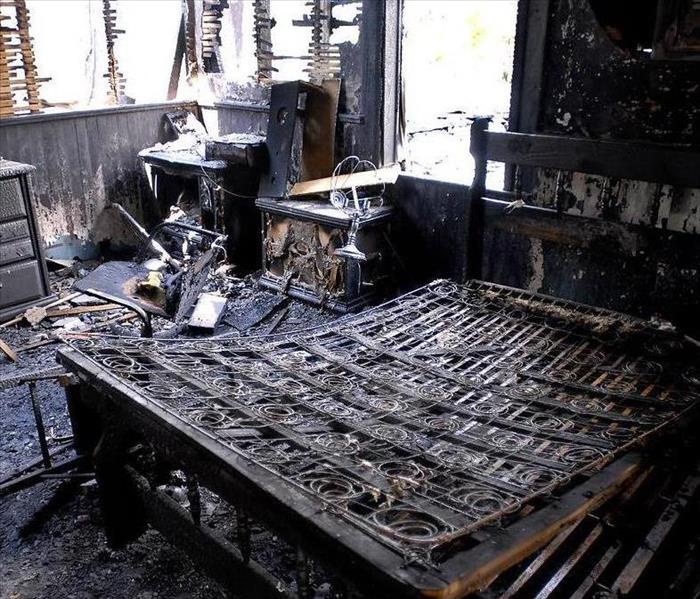 A phone charger sparked this fire in a bedroom.
A phone charger sparked this fire in a bedroom.
The majority of us sleep with our cell phone within arm’s reach, on our nightstand or tucked under our pillow. It’s become common to charge them overnight when they won’t be in use. SERVPRO of The Dutch Fork has responded to a number of house fires caused by the device we use every day. While it’s not usually the device itself but the charger that starts the fires.
Exposed wires, poor quality manufacturing and the location of the charger are all likely sources of the flames. Chargers produces a large amount of energy, which is why the cord is surrounded by a protective material. Once that protective layer becomes compromised, the entire cord is subject to malfunction. We’ve seen children’s mattresses completely charred; entire houses crumbled to the ground amongst many devastating home fire situations.
- Ensure that you purchase devices and chargers that have been quality tested in a laboratory setting.
- Use only the battery and charging cord that is designed for your device.
- A cheap price point usually means cheap manufacturing – do your research before looking for the best deal.
- Never charge your phone under a pillow, on your bed or in direct sunlight.
Your home is one of the biggest investments you’ll make, don’t let a charger cord be what takes that away from you!
Fire Safety - Preparing Your Children
7/17/2020 (Permalink)
Holding regular conversation with your children regarding fire safety is a great learning tool for both you and those young minds! Discussing the dangers of fire, how they can start and what to avoid that might accidentally cause a fire, are all great starting points. In school, your children practice fire drills; they learn what to listen for, where to go and how to exit the building safely. Practicing a fire drill at home can become part of your regular routine to ensure your children know how to detect a fire, and most importantly, how to get out safely.
- Test your fire alarms monthly to make sure the batteries have not gone bad. This also familiarizes your children with the high-pitched noise or beep it makes, alerting them to a fire.
- Create an exit plan – draw a map of your home for each child from their bedroom that takes them to the closest exit.
- If you live in a home with multiple stories, consider a fire ladder that hangs from a window to help you escape. Store it in a visible location, and let everyone know where it is.
- Children often want to re-enter a home during a fire if they’ve left a prized possession, pet or other cherished item. Teach and remind them to “get out, stay out”. Only professional firefighters should enter a building that is on fire.
- Check windows for proper function. A window that is painted shut or unable to open could limit the number of exits your family has.
- Teach and practice STOP, DROP and ROLL if your children’s clothes were to catch on fire this method could save their lives.
Fire education can certainly be fun, but more importantly, can save the lives of your family members. Never assume anyone in your home will know what to do in the event of an emergency. Hold a family meeting and organize your thoughts together, that way everyone is on the same page with the plan.
For more helpful tips and ideas on emergency preparedness be sure to visit https://www.redcross.org/get-help/how-to-prepare-for-emergencies/emergency-preparedness-for-kids.html
Professional Cleaning of Fire Damage
7/9/2020 (Permalink)
No matter the size or magnitude, fire can affect your entire home or business. Flames, heat, soot and smoke travel quickly – we’ve seen a small stove fire in a downstairs kitchen result in soot residue in a third-floor bedroom. We always advise hiring a cleaning professional to examine and perform the work necessary following any fire.
Our SERVPRO of The Dutch Fork Fire team is certified by the IICRC in Fire Restoration. That means they understand how fire, smoke and soot residue travel, affect materials, and how they should be restored. Our team is careful to maneuver in a way that does not cause further damage to the home. Walking on contaminated areas can track soot residue into other rooms, creating additional cleaning that has to be done. You must also take precautions due to possible structure damage. Floors can become weakened and support beams brittle after a fire, your safety should be the #1 priority.
The fire team at SERVPRO of The Dutch Fork is prepared to handle any fire job, the RIGHT way. We understand that being displaced by fire creates an immense amount of stress on homeowners as well as business owners, and we do our best to comfort, reassure and help them through the entire process. If you or someone you know has experienced a fire and is struggling to get back on their feet, please reach out to us, we’re connected with many organizations that help individuals get the assistance they need.
The Shocking Truth of Electrical Fires
7/9/2020 (Permalink)
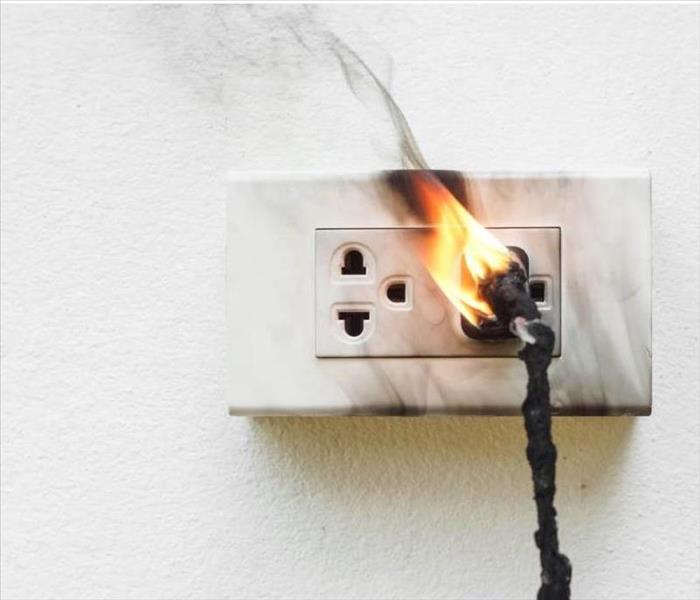 If your home or business has experienced an electrical fire, Call the pros at SERVPRO!
If your home or business has experienced an electrical fire, Call the pros at SERVPRO!
Did you know there are well over 25,000 electrical fires that occur each year in the United States? The damage that results from those fires can be detrimental to a business. Not only do the flames, heat and smoke diminish the structure, but the efforts made by firefighters to extinguish the fire often cause significant water damage. We know that all fires are preventable, especially electrical ones. As business owners you may wonder what proactive steps you might be able to take in order to avoid a costly and potentially fatal blow to your livelihood. The most effective solution we recommend is to regularly inspect any and all electrical sources. A licensed electrician can help check all electrical systems and determine if there are areas of concern.
Wiring – faulty wiring can mean many things, all of which are not good for your building or office. There are many signs that your wiring could potentially have issues – check out this site that names just a few https://electricalconnection.org/news/6-warning-signs-of-faulty-electrical-wiring-in-your-home-103
Cords and Plugs – electrical cords are one of the most common causes of electrical fires. Extension cords, outlets and plugs can become damaged over time and increase the chances of sparking which leads to fires. Regularly check the condition of all cords, look for fraying, exposed wires and bent plugs that, when plugged into a receptacle, become dangerous. Also make sure you’re using the correct extension cord or power strip for the device or appliance you have plugged in. Overloading either one of those can cause a surge in electricity and spark a fire.
Outlets – similar to extension cords, are designed to produce a predetermined amount of electricity. There are many devices that allow you to plug multiple cords into one outlet and if you’re not mindful, you can quickly overload that circuit. Check to see if you’re outlet faces are warm or visibly damaged. If using a power strip on an outlet, The United States Fire Administration recommends purchasing products equipped with internal overload protection. This feature forces the device to shut off it its power supply becomes overloaded, preventing a fire.
Space Heaters – should be carefully placed away from flammable material such as clothing, paper, fabric and electronics. The heat supplied by these appliances can melt items within a small radius.
A few minutes of your time, or a simple phone call to a professional, could save your business – studies show that 80% of businesses that experience a water or fire loss never reopen. Don’t let yours become one of them!
Fire Pit Safety
7/1/2020 (Permalink)
Since we’ve been spending significantly more time in our homes, the number of DIY and home improvement projects have been much higher than typical. If you’ve visited a home improvement or hardware store lately, it’s pretty evident what people are spending their time on. With the closing of restaurants, bars and places to hang out with friends our backyards have become a popular hangout spot. Maybe you purchased a new grill and have deemed yourself a BBQ Pitmaster, or built a new deck! But what’s better than a summer evening spent around a fire, cold beverage in hand and a comfy chair? Not much, in our opinion.
Fire pits are a simple and affordable addition to any backyard and can provide a variety of uses for your family and friends. Want to roast hotdogs or marshmallows? Host a socially distanced cocktail hour? Keep those pesky South Carolina mosquitoes away? Before you head off to the store to purchase one or if you’re brave enough to build it yourself – consider a few things:
Where Will You Place It?
After you determine whether you’ll be installing a permanent fire pit or purchasing a portable one, you’ll need to decide where it will go. Fire pits should always be placed at least ten feet from your home and any neighboring homes. You should also pay attention to any overhanging branches, fences, and other items that could potentially catch fire.
What Will You Place It On?
You’ll need a level surface made up of a fire pit safe surface. Brick, stone, gravel, concrete or some other fire-resistant composite material is your best bet. Ensure you have enough material surrounding the outside of the fire pit to extinguish any stray sparks or ash. NEVER place your fire pit on a wooden deck, inside of a garage or other enclosed area.
Safety Tips
It goes without saying that fire is dangerous, it must be closely monitored and those around it should take great precaution to avoid burns or serious injury. Some insurance companies require the disclosure of a fire pit as a requirement of your policy. Avoid loose fitting clothing around the fire as well as clothing made of flammable materials like nylon. If you have long hair, pull it back when starting the fire, especially if you’re using an accelerant like lighter fluid or gasoline.
Soft woods like cedar and pine have a tendency to spark and pop, avoiding them can reduce your risk of injury or fire spread. It’s also important to understand the proper way to extinguish your fire and dispose of the ashes. Never using anything other than water if you choose to extinguish with a liquid. A flammable liquid can create large bursts of flames.
Smoke Damaged Contents Can Be Saved!
1/24/2020 (Permalink)
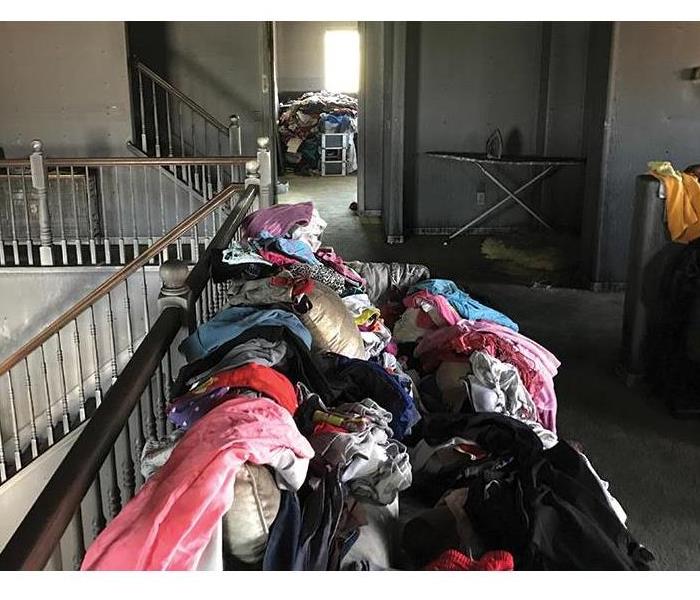
When we’re called in to help a homeowner that has experienced a fire related loss, we prepare to spend a generous amount of time at their property. Water and mold related jobs generally take a few days to a week to complete drying but, fire damage is a category of its own. In some instances, we face smoke, soot and water damage from the efforts taken by firefighters. As we assess the damage, we remain optimistic that the majority of contents within the structure can be cleaned and salvaged. Using SERVPRO products and training gained through Fire Restoration courses, we sort items and begin restoring. Often, we’re able to clean on-site and avoid incurring additional costs of packing and transporting items. Fabric items like clothing, bedding and furniture need to be cleaned off-site because of the processes and equipment necessary. We work with several textile restoration organizations that help us speed up this process and get your belongings back to you as quickly as possible. They’re able to remove visible smoke and soot as well as the pungent odor that fire often leaves behind. SERVPRO practices a “restore rather than replace” mentality which saves our customers money and preserves the memory of precious items.
Restoring Your Property After A Fire
1/8/2020 (Permalink)
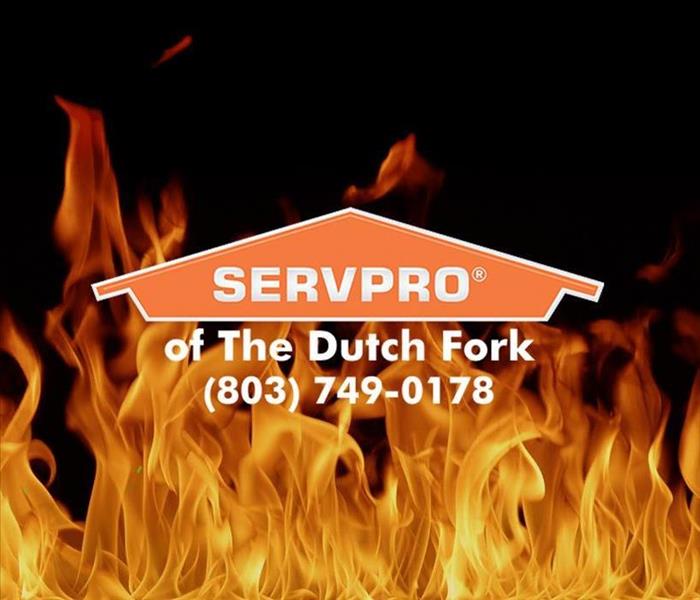 For all of your fire remediation needs, call the pros!
For all of your fire remediation needs, call the pros!
When the First Responder vehicles depart, your home is likely to show signs of fire and smoke damage, with some degree of water damage from efforts made by firefighters to extinguish the flames. SERVPRO of The Dutch Fork has a team of men and women with the specialized fire restoration training needed to make your home “Like it never even happened.”
Have Questions About Fire, Smoke, or Soot Damage? Call Today 803-749-0178
Every fire damage is unique. The type of structure, contents inside and overall environment requires a specific plan of action, but our recommended general process stays the same. The steps listed below illustrate our process for the standard fire damage mitigation:
Step 1: Initial Contact
The clock starts when you call SERVPRO of The Dutch Fork, we’re available 24 hours a day, 7 days a week. Our representative will ask a series of questions about what happened, the state of the home and the contents inside the home. This helps our team prepare to arrive with the proper equipment and resources.
Step 2: Inspection and Assessment
Our team will carefully walk the home in order to inspect and test several factors. The structural damage must be analyzed to predict repairs and any permits that will need to be applied for. The contents will be filed in an inventory log and separated into categories of salvageable and unsalvageable. This is determined by a set of regulated standards. This step is crucial in developing a plan of action to move forward. Moisture levels will be read throughout the home to determine where equipment is needed.
Step 3: Securing the Property
Fire typically damages the integrity of windows, walls, and roofs. To maintain security and to protect against further damage, we can board up missing windows and walls and place tarps on damaged roofs. It’s important to keep unwanted humans and wildlife out of the home during this time.
Step 4: Water Mitigation and Dry-out
The water removal process begins the first day our crews arrive. Using extraction to remove the water from various materials allows us to place dehumidifiers and air movers to dry out any residual moisture. If this is not done quickly, the possibility of mold growth is likely.
Step 5: Smoke and Soot Removal
We will use specialized equipment and techniques to remove smoke and soot from ceilings, walls, and other surfaces. Our technicians have been trained to perform this task the correct way, without proper equipment and products, it is possible to spread the smoke and soot making surfaces unsalvageable.
Step 6: Cleaning and Sanitizing
We clean all salvageable items that the homeowner wishes to keep. This includes furniture, flooring, and fabric type items. We use a variety of cleaning techniques to restore your belongings to pre-fire condition and have contacts with specialist companies that can handle those we don’t have the ability to tackle. We’re able to remove the odor of smoke with the help of air-scrubbers and ozone machines. Smoke and soot particles infiltrate the pores of porous material which harbors odors that become difficult to mask.
Step 7: Restoration
The most important part of any of our processes ties back to our motto – “Like it never even happened.” We strive to leave each property we work on in the same condition and often better than it was before any damage occurred. SERVPRO of The Dutch Fork is a start-to-finish franchise with the ability to rebuild most anything. We work with property owners to discuss upgrades and what their insurance will cover as far as replacement before we begin any work.
Candle Burning Safety
1/2/2020 (Permalink)
Who doesn’t love candles? They’re an easy way to make a space smell better, cozy up your living room or allow you to relax when soaking in the tub. There are so many scents, colors and even some that crackle like real wood while they burn.
With a flame so small it’s not hard to neglect the fact that they are a hazard in enclosed spaces. According to the National Fire Protection Association, nearly 8,700 residential fires are caused by candles each year. Close to one-third of them begin in bedrooms where people have fallen asleep.
While some of these fire stem from the neglect of an open flame, they also begin with poor placement and accidental bumping/knocking over. The National Fire Protection Association provides a wealth of knowledge in fire prevention and best safety practices.
- Candles should never be used as a night light, the risk of falling asleep with an open flame more likely when tired.
- Keep candles in an open area – at least 1 foot from anything flammable (fabric, aerosol, electrical outlets).
- Keep hair, clothing, and blankets away from flames.
- Never touch or move a lit candle.
- If oxygen is being used in the home an open flame of any sort should not be used.
- Before burning, always trim the wick to ¼ inch. Long or crooked wicks can cause sparks, drips and flares.
- Avoid burning candles all the way down, especially if they are not contained in a glass jar.
Fires are devastating, your home and all of its contents could be consumed in a matter of minutes. Take a few extra minutes to ensure you’re taking all necessary safety precautions before you ignite your favorite scent!
Protecting Your Business After A Fire
8/22/2019 (Permalink)
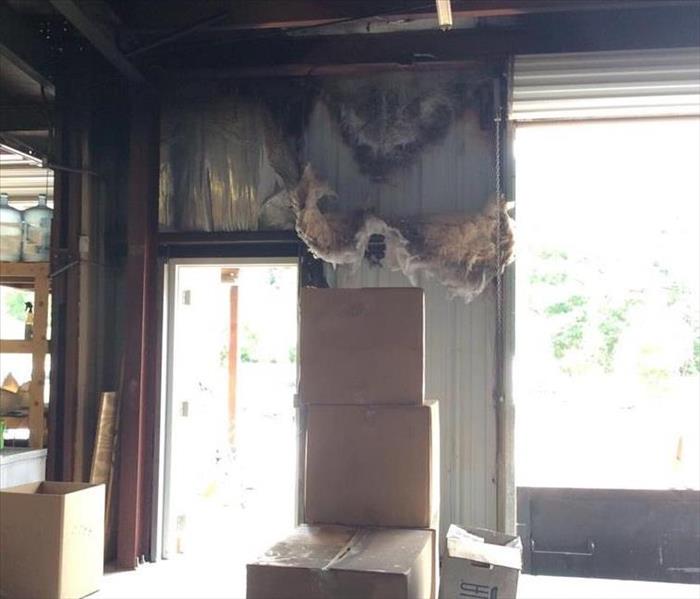 This warehouse experienced a fire stemming from an ice machine. All contents, walls and ceilings were cleaned and burned materials removed.
This warehouse experienced a fire stemming from an ice machine. All contents, walls and ceilings were cleaned and burned materials removed.
If your Columbia, SC business has experienced a fire it’s likely that you’re unsure how to proceed. The two most important steps of restoring any building that has experienced fire damage, no matter how large or small the fire, are:
- Protecting the property
- Cleaning affected areas/materials
First – Call Your Insurance Agent
One of the first calls you should make (after 911 of course) should be to your insurance agent. They can help you determine if you should file a claim or pay out of pocket for the steps necessary to restore your business. If the fire was small, let’s say a break room kitchen fire or something similar, you very well could be better off not filing a claim against your insurance. Your agent may also recommend a restoration service they know and trust to help you with the cleanup process while protecting your property from further harm.
Second – Contact a Restoration Service
Soot and smoke are extremely difficult to clean without the proper knowledge and equipment to do so. We always recommend calling a professional fire restoration service to handle this. SERVPRO of the Dutch Fork offers board-up services to secure your property and keep unwanted guests and animals out. We also offer tarping services if damage has occurred to the roof. This prevents water from gaining access to the space and causing further damage.
If water was used to extinguish the fire you may also be facing water damage, this requires a restoration company also. If the water damage is left untreated, you’ll likely be facing issues with mold down the road.
Has your business suffered fire damage? Call SERVPRO of the Dutch Fork, the trusted leader in the restoration industry for fire damage restoration.
Post-Fire Boardups
7/11/2019 (Permalink)
In a recent visit with an insurance agent I presented one of our free services to clients in need; after a residential or commercial fire SERVPRO of The Dutch Fork will board up the windows and entry ways of a structure. We offer this free of charge because the property owner is already under enough distress, why add to that? Our staff secure quality boards with our logo on them to any windows that may have been broken and doors that are compromised. The agent wanted to know why a burnt building would need such a thing?
There are several reasons why you might want to board up structural damage or windows. In addition to protecting the structure from the outdoor elements, you also help to prevent unwanted intruders.
- If items are left in your home with unsecured entry-ways, you’re likely to fall victim to theft. It’s hard to keep sticky fingers out with a clear entrance to your home or building.
- Chances are the water used to extinguish the fire has already created some water damage within your home or building. It could be weeks before a roof is replaced or windows installed. Exposure to additional water, wind or sun can increase the damage caused by smoke and soot.
- Limiting the amount of unnecessary foot traffic. Soot damage is hard to clean and even harder to clean when it becomes embedded into carpeting or upholstery. Securing entrances can reduce the number of footprints you’ll see.
Talk to restoration experts at SERVPRO of The Dutch Fork, about whether boarding up is a good strategy for preventing loss and limiting damage after a fire. Your major concern is likely to be how to recover from fire damage as quickly and completely as possible. Preventing looting and exposure to the elements can make fire cleanup more successful. Don’t hesitate to call us (803) 749-0178.
Our Top Tips for Fire Damage
7/9/2019 (Permalink)
Fire damage restoration is tough work. Homeowners and Insurance Adjusters call SERVPRO of The Dutch Fork frequently to ask for advice on how to clean up after a fire. We’ve put together seven of the best tips we give people who ask about fire damage restoration.
Most people are capable of completing the majority of these tips, but, remember that fire damage restoration takes time, work, and skill. Realistically consider whether you want to try these ideas on your own or whether you’d be better off hiring highly trained restoration specialists who will guarantee their work.
With any type of fire, you’ll have a percentage of smoke damage to your walls, molding, and paint. If the smoke damage is light, you should be able to scrub it clean with detergents and bleach. Soot from smoke damage is greasy stuff, so always try to dust as much of it off from a surface before trying to scrub the surface clean. Often, you’ll want to repaint, but make sure all surfaces are clean and dry before you paint.
- Limit Activity & Other Simple Fire Damage Restoration Steps
Until your house is restored, limit your activity and movement in the house. This helps prevent soot particles from being embedded into upholstery and carpets that can be generated from foot traffic. Keep hands clean so you don’t further soil upholstery, walls, and woodwork. Protect your things by placing clean towels or old linens on rugs, upholstery, and carpet traffic areas. Before you clean know the best cleaning method for that particular cleaning job (one example: Clean and protect chrome with a light coating of petroleum jelly or oil.) Wash both sides of the leaves on your houseplants. Change your HVAC filter and tape double layers of cheesecloth over air registers.
Firefighters are brave men and women; they save lives and extinguish fires. Extinguishing a fire does prevent the rest of the structure from being demolished. But they do introduce mold and mildew into houses when they must use water to extinguish the fire. SERVPRO of The Dutch Fork highly recommends you hire fire damage restoration professionals to deal with mold and mildew. Mold and mildew can cause serious health problems. It’s difficult for a nonprofessional to administer and complete the necessary tests that indicate moisture and mold levels. Mold and mildew can contaminate your furniture, carpets, clothing, mattresses, walls, and vents. The best thing you can do immediately is to air out every room and clean out all vents and filters.
- Replace Carpets. Clean and Dry Your Floors
Your floors and carpets act like a sponge for all of the water used to put out a fire. In almost every case, SERVPRO of The Dutch Fork recommends that you pull up any carpets that have water damage and replace them. Water can also seep underneath vinyl flooring and into the cracks in hardwood flooring. Again, it is difficult for a non-professional to administer and complete testing necessary for determining if hidden moisture is present.
- Avoid Smearing Soot into Clothing
Cleaning smoke damage from clothing is one of the biggest jobs you’ll have after a fire. Make sure you don’t smear the greasy soot into the clothing or just throw the smoky clothes into the wash. Often times dry cleaning is the best bet, and you should ask around local dry cleaners to see if any have experience with post-fire laundry. Removing smoke odor is a tricky task that requires the right equipment, cleaning products and skillset. We don’t recommend trying to complete this portion on your own.
- Scrub, Soak, And Cleaning Dishes
Dishes are also important items to clean thoroughly after a fire because they will be in contact with your food. Scrub all dishes well, let them soak in a solution of bleach and water (2 tablespoons of bleach per gallon) for at least 20 minutes and scrub some more for safety. When in doubt, if a dish, pot, or pan won’t come clean, cut your losses and throw it out – especially rubber or wooden dishes that absorb smoke.
Help Is Here
The team at SERVPRO of The Dutch Fork also has specialized training and experience in fire restoration services, natural disaster prevention, water damage, chemical cleanup, and natural disaster cleanup.
Call SERVPRO of The Dutch Fork for Cleanup and Restoration. Call (803 ) 749-0178.
What To Do After a Structure Fire in Chapin
1/22/2019 (Permalink)
If you've found yourself the victim of a structure fire, be it your home or office, it's quite likely that you're unsure of what your next steps should be. The following tidbits of information may be able to assist you in reducing the amount of additional damage and increase your chances of a successful restoration.
Do:
- Limit the amount of foot traffic within the property. Soot particles can be spread to unaffected areas and embed themselves into carpet and furniture fibers.
- Keep your hands clean. Transferring soot and other fire-related substances can further soil the walls, upholstery, woodwork, etc.
- Electricity is often turned off, empty refrigerators/freezers. Prevent food from perishing and open the doors after cleaning them out to prevent odors.
- Cover air registers with cheesecloth, and double layer the tape. Or any similar fabric that will keep soot particles out of the HVAC system.
- If your electricity is off, your heating system will not operate. In the winter, pour antifreeze designed for RV's and Campers in your sinks, toilet bowls, holding tanks and bathtubs to "winterize" your home and keep pipes from freezing.
Don't:
- Attempt to wash any walls or painted surfaces.
- Shampoo carpet or upholstery without contacting us.
- Clean any electrical items. Appliances, TV's, game consoles or cleaning devices that were close to the fire or water without consulting an authorized repair service.
- Use or consume any canned or packaged food or beverage that may have been near the fire, heat or water. Varying conditions can alter the integrity of food items.
- Turn on ceiling fixtures if the ceiling is wet, wiring can be damaged by the water.
- Send garments to an ordinary dry cleaner. Improper cleaning may cause smoke odor to set in.
Fire Extinguishers - What You Need To Know
1/16/2019 (Permalink)
If you were given five seconds to answer the following questions, could you?
- Where are the fire extinguishers in your home or office?
- How do you operate those fire extinguishers?
- What type of extinguisher(s) are they?
In the event of a fire you’ll need to know the answers to all of these questions and you’ll need to know them FAST. Fires can consume a building in a matter of minutes, the faster you’re able to create a plan and react, the better.
The Fire Triangle, which is technically a tetrahedron because it has four elements, explains what is necessary for a fire to exist. A fire needs oxygen to sustain combustion, heat to raise the material to its ignition temperature, fuel to support the combustion and a chemical reaction between these three elements to sustain itself. Removing any one of the four elements will extinguish the fire.
Placement
A fire extinguisher should be placed on each level of your home or office building, and especially in places where fires are more likely to occur, like the kitchen and garage. They should be easily accessible and never covered or surrounded.
Types of Fires
We’ll start by classifying the different types of fires. The source or cause of the fire and its location determine what must be used to extinguish it.
CLASS A: contain ordinary combustibles such as wood, paper, cloth, rubber and many plastics.
CLASS B: are in flammable liquids like gasoline, petroleum greases, tars, oils, oil-based paints, solvents and alcohols. Class B fires also include flammable gases such as propane and butane. These do no include fires involving cooking oils and grease.
CLASS C: involve energized electrical equipment like computers, servers, motors, transformers and appliances. Remove the power and the Class C fire becomes a different class of fire.
CLASS D: are fires in combustible metals like magnesium, titanium, zirconium, sodium, lithium, and potassium.
CLASS K: fires in cooking oils and greases such as animal and vegetable fats.
Types of Fire Extinguishers
Water and Foam: takes away the element of heat in the fire triangle. Foam agents also separate the oxygen from the other elements.
- Water Extinguishers are for Class A only – they should not be used on Class B or C fires. The discharge steam could spread the flammable liquid in a Class B fire or could create a shock hazard on a Class C fire.
Carbon Dioxide: take away the oxygen element of the fire triangle and also by removing the heat with a very cold discharge.
- Carbon dioxide can be used on Class B & C fires. They are usually ineffective on Class A fires.
Dry Chemical: extinguish the fire primarily by interrupting the chemical reaction of the fire triangle.
- The most commonly used type of fire extinguisher is the multipurpose dry chemical because it is effective on Class A, B and C fires. This agent also works by creating a barrier between the oxygen element and the fuel element on Class A.
Wet Chemical: a new agent that extinguishes the fire by removing the heat of the fire triangle and prevents re-ignition by creating a barrier between the oxygen and fuel elements.
- Wet chemical extinguishers or Class K extinguishers were designed for modern, high efficiency deep fat fryers in commercial cooking operations.
Clean Agent: Halogenated or Clean Agent extinguishers include the halon agents as well as the newer less ozone depleting halocarbon agents. They extinguish the fire by interrupting the chemical reaction and/or removing heat from the fire triangle.
- Clean agent extinguishers are effective on Class A, B and C fires.
Dry Powder: similar to dry chemical except they extinguish the fire by separating the fuel from the oxygen element or by removing the heat element of the fire triangle.
- Dry Powder extinguishers are for Class D or combustible metals fires only
Water Mist: take away the heat element of the fire triangle. They are an alternative to the clean agent extinguishers where contamination is a concern.
- Water mist extinguishers are primarily for Class A fires, although they are safe for use on Class C as well.
Use of A Fire Extinguisher
Remembering how to use any fire extinguisher is simple if you can remember the acronym P.A.S.S:
- Pull the pin
- Aim the nozzle or hose at the base of the fire from the recommended distance
- Squeeze the operating lever to discharge the fire extinguishing agent
- Sweep the nozzle or hose from side to side until the fire is out
Buying Guide
When purchasing a fire extinguisher, it is important to check the classification listed on the packaging. Manufacturers make it easier on consumers by labeling their products based on the type of fires they’re formulated to extinguish. Most home improvement stores carry products that carry Class A through Class C. Consider the types of materials within the are you're placing the extinguisher, in kitchens it is best practice to have one classified for grease fires as well as multi-purpose.
Smoke Detectors - Your First Line of Defense
1/2/2019 (Permalink)
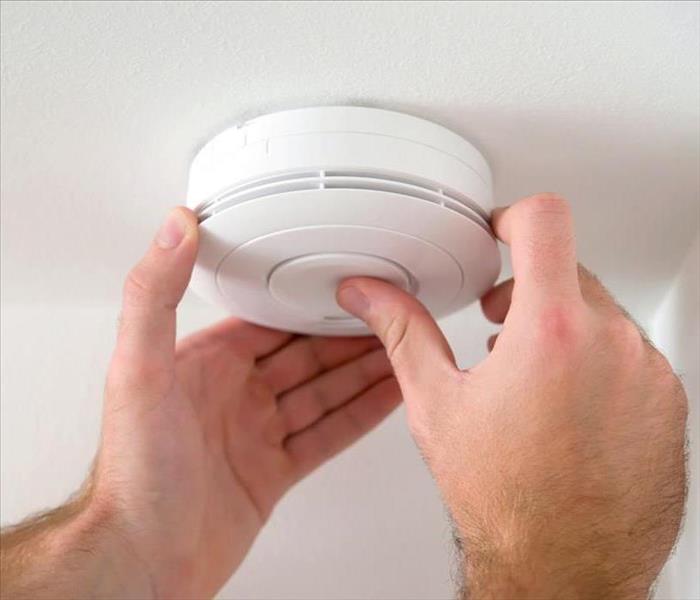 Your home is one of your biggest investments, protect yourself and your family!
Your home is one of your biggest investments, protect yourself and your family!
Think you don’t need a smoke detector? Think again!
Fires destroy numerous homes in Chapin and surrounding areas every year. One of the easiest ways you can prevent fire damage is early detection. Smoke detectors are inexpensive, easy to install and require very little maintenance. Properly maintained, they can keep your home and your family safe from harm.
There are many causes for house fires; faulty wiring, appliance mishaps, smoking, the list goes on and on. No matter the cause, fires are unpredictable and can be life shattering. Ensuring that your home has a functional smoke detector is one of the most important steps to reduce fire damage to your Chapin home. According to the South Carolina Fire Marshal, a smoke detector or alarm should be installed on the ceiling in every sleeping room, hallway and on every level of your home (this includes basements and attics).
The two most prominent types of smoke detectors are ionization and photoelectric.
Ionization: uses ions, or electrically charged particles that react to particles emitted in a fire, setting off the alarm. They are best at detecting fast-flaming fires that don’t emit much visible smoke. Most home fires are smoky and smoldering long before flames flare, ionization alarms are not as quick at detecting those. They can also be prone to nuisance alarms from cooking or steam, these should not be placed in the kitchen or bathrooms.
Photoelectric: contains a photo cell and a light beam that shines away from the cell. Once smoke enters the test chamber, some of the light becomes scattered by the smoke particles, which hits the cell and an alarm is triggered. They are best at detecting smoky and smoldering fires, which are most common in home fires. Dust or insects that enter the cell can cause false alarms so they should be cleaned occasionally.
There are several other types of smoke detectors and alarms, consider the conditions in which the device will be placed and the type of home you have before purchasing. If you’re unsure, pay a visit to your local Fire Station and they can guide you in the right direction!
After proper installation it is imperative that you maintain your devices by following these simple steps:
- Test the detector every month - we recommend the testing of smoke detectors at least once a month. This helps to determine if the battery is dead or if the alarm is working. To test the device, press the button until an audible alert tone sounds.
- Replace the battery - If you find the battery is dead, we recommend you replace it. Check the manufacturer’s instructions on how to replace the batteries. Each alarm is different but should have a function that identifies if the battery is low. But, be doubly cautious and follow the wisdom of replacing the batteries when you reset your clocks for Daylight or Standard Time.
- Vacuum the detector - After testing or replacing the batteries, we also recommend vacuuming the detector. This helps to remove any cobwebs, insects and dust build-up. Use a soft brush attachment for this process.
Following these maintenance tips should cut losses and possibly save your family. If an emergency or mishap does occur from fire, water or mold problem, call SERVPRO of The Dutch Fork 24/7 emergency line at (803) 749-0178.
Irmo Smoke and Soot Cleanup
8/27/2018 (Permalink)
Smoke and soot are very invasive and can penetrate various cavities within your home, causing hidden damage and odor. Our smoke damage expertise and experience allows us to inspect and accurately assess the extent of the damage to develop a comprehensive plan of action.
Smoke and soot facts:
- Hot smoke migrates to cooler areas and upper levels of a structure.
- Smoke flows around plumbing systems, seeping through the holes used by pipes to go from floor to floor.
- The type of smoke may greatly affect the restoration process.
Different Types of Smoke
There are two different types of smoke–wet and dry. As a result, there are different types of soot residue after a fire. Before restoration begins, SERVPRO of The Dutch Fork will test the soot to determine which type of smoke damage occurred. The cleaning procedures will then be based on the information identified during pretesting. Here is some additional information:
Wet Smoke – Plastic and Rubber
- Low heat, smoldering, pungent odor, sticky, smeary. Smoke webs are more difficult to clean.
Dry Smoke – Paper and Wood
- Fast burning, high temperatures, heat rises therefore smoke rises.
Protein Fire Residue – Produced by evaporation of material rather than from a fire
- Virtually invisible, discolors paints and varnishes, extreme pungent odor.
Our Fire Damage Restoration Services
Since each smoke and fire damage situation is a little different, each one requires a unique solution tailored for the specific conditions. We have the equipment, expertise, and experience to restore your fire and smoke damage. We will also treat your family with empathy and respect and your property with care.
Have Questions about Fire, Smoke, or Soot Damage?
Call SERVPRO of The Dutch Fork Today – 803-749-0178

 24/7 Emergency Service
24/7 Emergency Service



